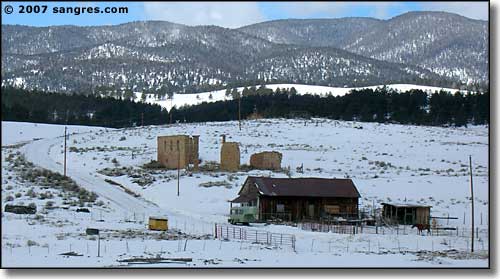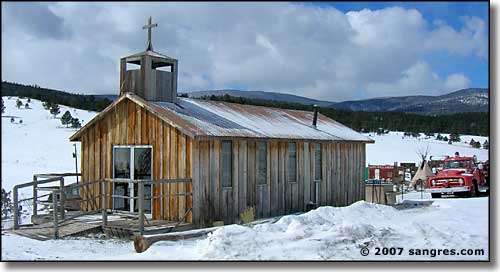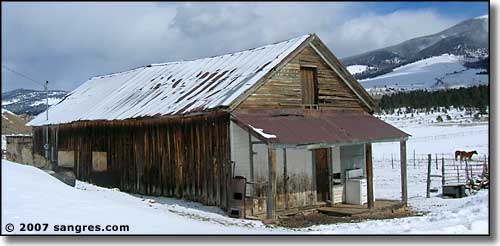
Elizabethtown, New Mexico

Elizabethtown from the highway
Elizabethtown was a model boom-and-bust mining camp in the late 1800's, five miles north of Eagle Nest along the Enchanted Circle Scenic Byway. What you see here is pretty much what's left standing in town. The E-town Museum, located in a former schoolteacher's home, is filled with books, clothing, pictures, maps, family heirlooms and other memorabilia from the time.
The "General Store" offers souvenirs, historic cards, handmade mountain man artifacts and other mementos for sale. You may want to visit during Gold Rush Days, July 3-5, with an old time trade fair, food, gunfights, and other activities. While in town, you might also want to visit with the E-town cemetary and discover a lot of history as told by the grave markers.

The most modern building in town

The Mutz Hotel with Baldy Mountain behind
In the fall of 1866, a lone Moache Ute showed up at Fort Union with a large chunk of copper ore. The federal government was shorting the Native Americans with food and such and he wanted to trade it for more winter supplies. Captain William Moore (retired), the owner of the suttler's store, recognized the rock for what it was and offered a deal to the Ute's liking. Part of the deal was that the Native American would lead the Captain to where he got the rock. That turned out to be on the west side of Baldy Mountain.
Moore sent three prospectors out to check out the ore deposit. While they were on the mountain, one of them decided to pan a bit of stream gravel and see what he might find. In the end, they dropped the copper ore project because they found flakes of gold in nearly every gully on the west side of the mountain. An early snowstorm forced them off the mountain and when they returned to Fort Union, the principals in this venture all swore each other to secrecy. However, it was a long winter and stories get told. By the spring of 1867, there were 300 men waiting at Fort Union to charge onto the mountain and stake their claims. Problem was, all this countryside was the private property of Lucien Maxwell as part of the Maxwell Land Grant.
Maxwell had dreamed of managed and controlled growth on his property but the gold rush that occured in 1867 put an end to that. He ended up establishing lease agreements with most of the miners and then built his own mining operation on the mountain.
Elizabethtown was founded that summer of 1867 by the miners. The town was surveyed and platted with wide streets and separate residential and commercial zones. That first summer five stores opened for business. However, winter can be pretty harsh at that elevation and the miners couldn't work their claims.
In the meantime, Maxwell built a toll road through Cimarron Canyon and leased land to Uncle Dick Wootton to build a toll road over Raton Pass to Trinidad. This was necessary to get the gold out of the Moreno Valley and deposit it in the banks in Trinidad. By the spring of 1868, there was a stage line offering daily service between Elizabethtown and Cimarron. This route was so successful that the owner soon instituted another stage line to Taos and Santa Fe.
By the end of summer in 1868, there were 3,000 men working the gold fields and 100 buildings built in Elizabethtown. In January, 1869, the state legislature created a new county and named it Colfax in honor of the Vice-President elect, Schuyler Colfax. As the largest town in the county, Elizabethtown was the first county seat. A year later, Elizabethtown became the first incorporated city in New Mexico. None of this meant that this gold camp was civilized: in one 24-hour period, there were 8 isolated confrontations that left men dead.
The outlaw problem was so bad, and the law so ineffectual, that vigilante justice became the norm. Lots of folks were killed simply because someone in a position of influence didn't like them. There were even instances when the vigilantes stormed the jail and hung whoever was inside. Too many times, the dead men turned out to be innocent.
One of the nastiest of the vigilantes was a former Confederate officer named Clay Allison. Allison had a ranch over towards Cimarron but every now and then he just had to go to town somewhere (he also regularly showed up in Trinidad because Trinidad had the best doctors: he'd picked up a nasty social disease and had to seek regular treatment). Allison's fame as a gunfighter, nasty drunk and vigilante activist stretched as far away as Dodge City. He was usually the leader of the groups that stormed the jail. He was also a squatter on Maxwell's property.
In 1870, Maxwell decided to sell the Land Grant and move to the abandoned Fort Sumner. A year later, the Grant was bought by a consortium of British and Dutch investors. These investors honored any property owner who had proof that he'd bought the land from Maxwell, but squatters were to be evicted. This led to the Colfax County War.
Within two years, the county seat was moved to Cimarron, close to the headquarters of the Maxwell Land Grant Company. By 1875, the boom days of gold mining were over and Elizabethtown was in swift decline. Then in 1887, the US Supreme Court finally ruled in favor of the Land Grant owners (that the Land Grant was valid private property) and things picked up again. Mind you, one of the local folks was Tom "Black Jack" Ketchum, a notorious train robber with his Hole-In-The-Wall Gang. They hung out in Elizabethtown a lot, spending hundred-dollar bills that no one could account for in all night poker games. Black Jack was finally shot during a botched train robbery and was caught, tried and hanged in Clayton in 1901.
But life in E-town was more sane and civil than it had been in the early years, until a fire broke out in 1903 that destroyed most of the town. It was after the fire that the Mutz Hotel was rebuilt in stone but the town didn't recover. The death knell really came when Charles and Frank Springer decided to build a dam near the entrance to Cimarron Canyon. That created Eagle Nest Lake. TD Neal bought land next to the lake and founded the town of Therma (later to be called Eagle Nest). Most of the remaining residents of E-town took their houses apart and moved everything down to Therma over the next couple of years.
Gold mining continued on Baldy Mountain up into the 1940's but it wasn't very profitable because there was a shortage of water for hydraulic placer mining, and the laws were also getting stricter in regards to water pollution. Most of the land on the east side of Baldy Mountain was purchased and donated to Philmont Scout Ranch in 1962 so all mining has ceased over there.
At this point, there are only 7 of the original buildings of E-town left "standing." And the town itself is in the hands of descendants of the Mutz family.

Another view of the Mutz Hotel

The "General Store" and E-town Museum, straight ahead

